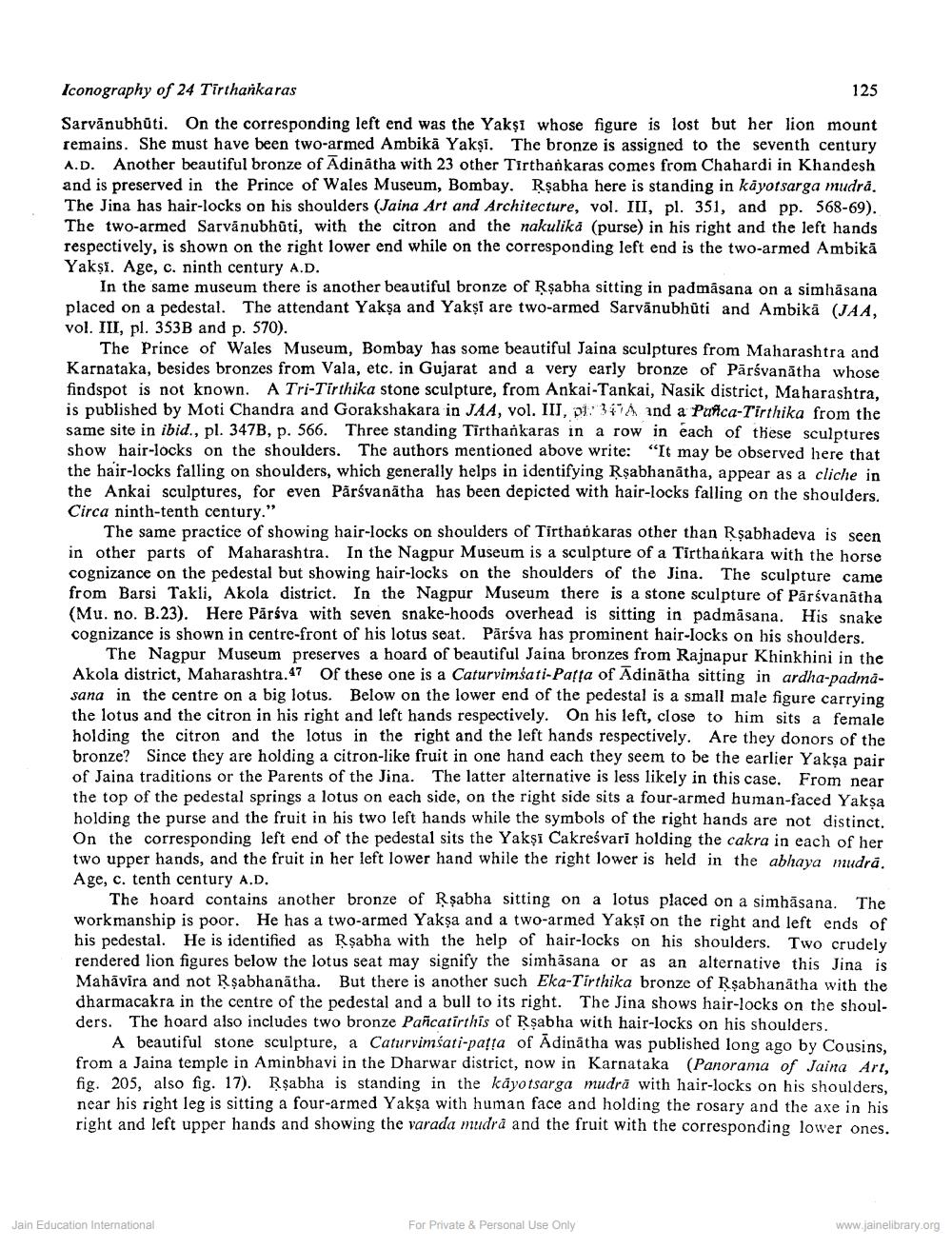________________
Iconography of 24 Tirthankaras
125
Sarvānubhūti. On the corresponding left end was the Yakṣi whose figure is lost but her lion mount remains. She must have been two-armed Ambika Yaksi. The bronze is assigned to the seventh century A.D. Another beautiful bronze of Adinātha with 23 other Tirthankaras comes from Chahardi in Khandesh and is preserved in the Prince of Wales Museum, Bombay. Rşabha here is standing in kāyotsarga mudra. The Jina has hair-locks on his shoulders (Jaina Art and Architecture, vol. III, pl. 351, and pp. 568-69). The two-armed Sarvänubhūti, with the citron and the nakulika (purse) in his right and the left hands respectively, is shown on the right lower end while on the corresponding left end is the two-armed Ambikā Yaksi. Age, c. ninth century A.D.
In the same museum there is another beautiful bronze of Rşabha sitting in padmāsana on a simhasana placed on a pedestal. The attendant Yaksa and Yaksi are two-armed Sarvānubhüti and Ambika (JAA, vol. III, pl. 353B and p. 570).
The Prince of Wales Museum, Bombay has some beautiful Jaina sculptures from Maharashtra and Karnataka, besides bronzes from Vala, etc. in Gujarat and a very early bronze of Pärávanātha whose findspot is not known. A Tri-Tirthika stone sculpture, from Ankai-Tankai, Nasik district, Maharashtra. is published by Moti Chandra and Gorakshakara in JAA, vol. IIT, PI: 347A ind a Panca-Tirthika from the same site in ibid., pl. 347B, p. 566. Three standing Tirtharkaras in a row in each of these sculptures show hair-locks on the shoulders. The authors mentioned above write: "It may be observed here that the hair-locks falling on shoulders, which generally helps in identifying Rşabhanātha, appear as a cliche in the Ankai sculptures, for even Pārsvanatha has been depicted with hair-locks falling on the shoulders. Circa ninth-tenth century."
The same practice of showing hair-locks on shoulders of Tirtharkaras other than Rşabhadeva is seen in other parts of Maharashtra. In the Nagpur Museum is a sculpture of a Tirtha nkara with the horse cognizance on the pedestal but showing hair-locks on the shoulders of the Jina. The sculpture came from Barsi Takli, Akola district. In the Nagpur Museum there is a stone sculpture of Pārsvanatha (Mu, no. B.23). Here Pārsva with seven snake-hoods overhead is sitting in padmāsana. His snake cognizance is shown in centre-front of his lotus seat. Pärśva has prominent hair-locks on his shoulders.
The Nagpur Museum preserves a hoard of beautiful Jaina bronzes from Rajnapur Khinkhini in the Akola district, Maharashtra.47 of these one is a Caturvimšati-Pafta of Adinātha sitting in ardha-padmasana in the centre on a big lotus. Below on the lower end of the pedestal is a small male figure carrying the lotus and the citron in his right and left hands respectively. On his left, close to him sits a female holding the citron and the lotus in the right and the left hands respectively. Are they donors of the bronze? Since they are holding a citron-like fruit in one hand each they seem to be the earlier Yaksa pair of Jaina traditions or the Parents of the Jina. The latter alternative is less likely in this case. From near the top of the pedestal springs a lotus on each side, on the right side sits a four-armed human-faced Yaksa holding the purse and the fruit in his two left hands while the symbols of the right hands are not distinct. On the corresponding left end of the pedestal sits the Yakși Cakreśvari holding the cakra in each of her two upper hands, and the fruit in her left lower hand while the right lower is held in the abhaya mudra. Age, c. tenth century A.D.
The hoard contains another bronze of Rşabha sitting on a lotus placed on a simhāsana. The workmanship is poor. He has a two-armed Yaksa and a two-armed Yaksi on the right and left ends of his pedestal. He is identified as Rşabha with the help of hair-locks on his shoulders. Two crudely rendered lion figures below the lotus seat may signify the simhasana or as an alternative this Jina is Mahavira and not Rşabhanātha. But there is another such Eka-Tirthika bronze of Rşabhanatha with the dharmacakra in the centre of the pedestal and a bull to its right. The Jina shows hair-locks on the shoulders. The hoard also includes two bronze Pañcatirthis of Rşabha with hair-locks on his shoulders.
A beautiful stone sculpture, a Caturvimśati-patta of Adinātha was published long ago by Cousins, from a Jaina temple in Aminbhavi in the Dharwar district, now in Karnataka (Panorama of Jaina Art, fig. 205. also fig. 17). Rşabha is standing in the kayotsarga mudrā with hair-locks on his shoulders. near his right leg is sitting a four-armed Yaksa with human face and holding the rosary and the axe in his right and left upper hands and showing the varada mudra and the fruit with the corresponding lower ones.
Jain Education International
For Private & Personal Use Only
www.jainelibrary.org




